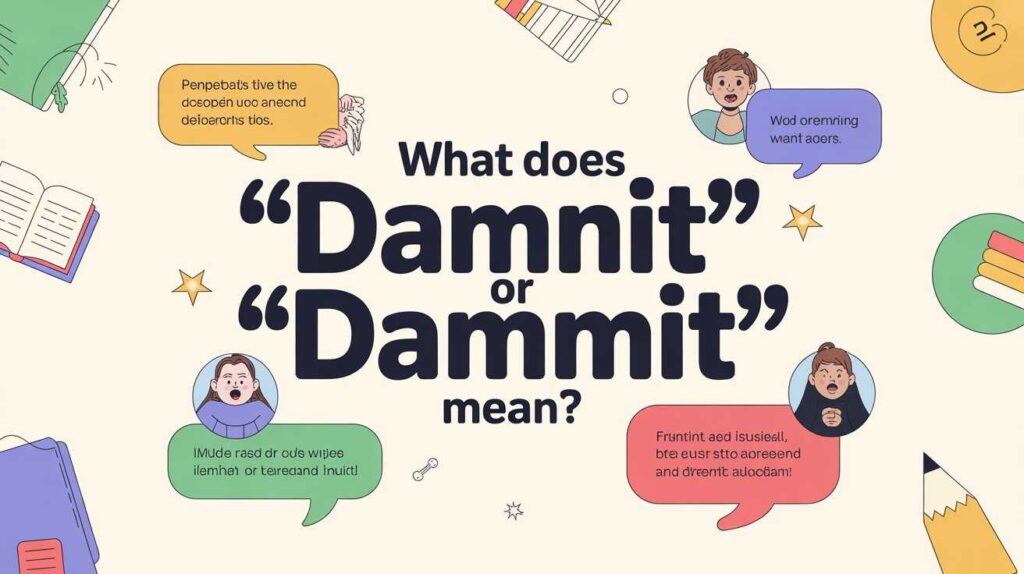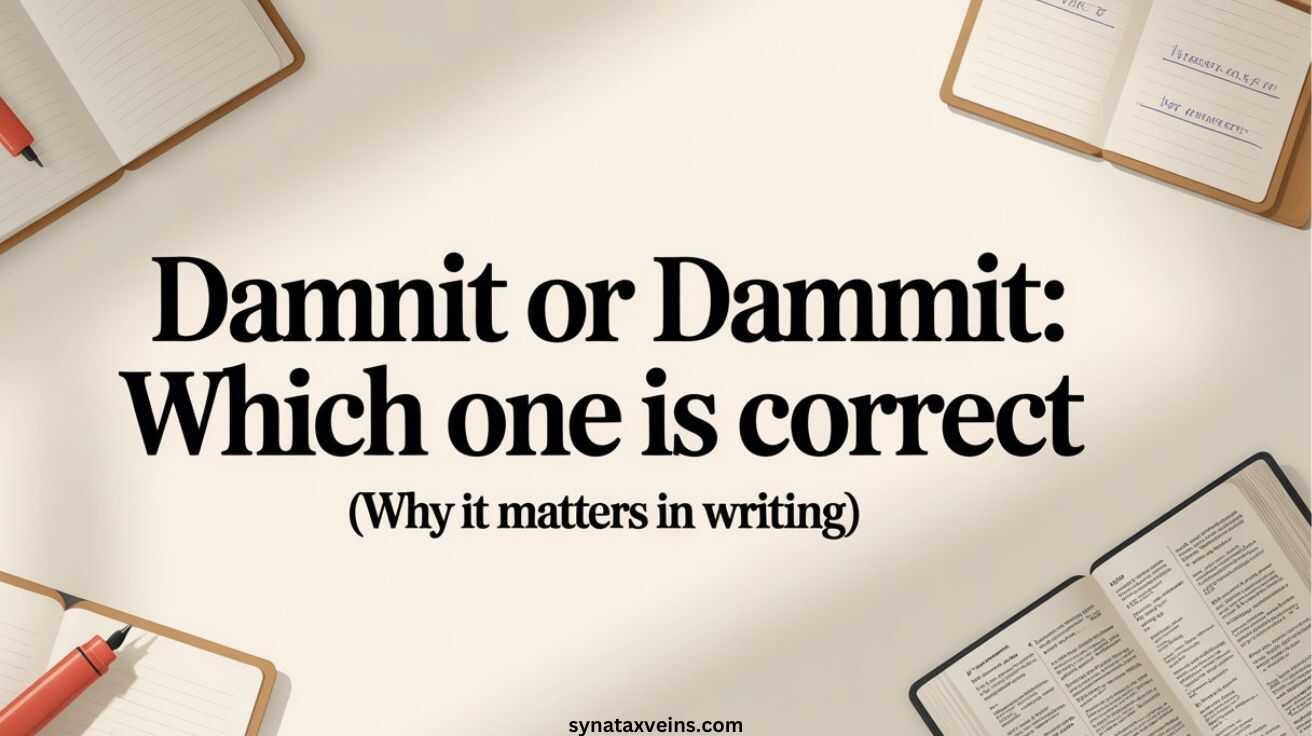Language can be tricky, especially when emotion enters the picture. You’ve probably seen people write damnit, dammit, or even damn it — but which one is actually correct? The answer depends on grammar, tone, and context. Understanding the difference between “damnit” and “dammit” isn’t just about spelling — it’s about expressing emotion the right way in writing.
What Does “Damnit” or “Dammit” Mean?

Both damnit and dammit are emotional expressions — often used to show frustration, annoyance, or anger. Essentially, they’re phonetic spellings of the phrase “damn it.”
- “Damn it” is the grammatically correct form.
- “Dammit” is an informal, phonetic version commonly used in casual or emotional writing.
- “Damnit” is considered a misspelling of dammit — though it appears frequently online.
Example:
“Dammit! I forgot my wallet again.”
Here, the word reflects emotional release — not a literal curse, but an expression of irritation.
Damnit or Dammit: Quick Comparison Table
| Form | Type | Correctness | Common Use | Example |
|---|---|---|---|---|
| Damn it | Phrase | ✅ Grammatically correct | Formal & informal writing | “Damn it, I missed the bus!” |
| Dammit | Slang / informal contraction | ✅ Accepted in casual writing | Social media, fiction, dialogue | “Dammit, that’s frustrating.” |
| Damnit | Misspelling | ❌ Incorrect (nonstandard) | Internet slang, typos | “Damnit, why does this always happen?” |
Verdict: ✅ Use dammit for emotional, casual writing and damn it for grammatically correct or formal usage.
The History and Evolution of “Dammit”
The word damn dates back to Middle English and Latin “damnare,” meaning to condemn. Over centuries, it became a mild profanity — expressing frustration rather than literal condemnation.
When people began writing as they spoke, damn it often appeared phonetically as dammit. This informal spelling captured the emotional tone and rhythm of speech, making dialogue more authentic — especially in literature and pop culture.
By contrast, damnit emerged later as a spelling mistake, caused by fast typing or misheard pronunciation.
So, while dammit is informal but accepted, damnit remains a nonstandard variant.
Damn It or Dammit: Which One Should You Use?
The choice between damn it and dammit depends on your tone and audience:
- Use “damn it” in formal writing, academic essays, or articles.
- Use “dammit” in casual messages, fictional dialogue, or creative writing.
- Avoid “damnit” if you want to maintain writing accuracy.
Example Comparison:
| Sentence | Appropriate Context |
|---|---|
| “Damn it, I lost the keys again.” | Polished or semi-formal writing |
| “Dammit, this level is impossible!” | Conversational tone or texting |
Why “Damnit” Feels So Common Online
You’ll often see “damnit” across social media, memes, and texting threads. That’s because it looks natural when people type quickly — but it’s still technically incorrect.
This confusion is fueled by:
- Casual writing habits online
- Auto-correct errors
- Visual similarity to “dammit”
Think of damnit like writing “gonna” instead of “going to” — people understand it, but it’s not standard English.
Dammit vs Damnit: Real Examples in Use
| Platform | Common Form | Example |
|---|---|---|
| Twitter/X | Dammit | “Dammit, I forgot to charge my phone again.” |
| Dammit | “Dammit, this update broke everything.” | |
| Instagram captions | Damnit | “Damnit, why do vacations end so fast?” |
| Movies/TV dialogue | Dammit | “Dammit, Jim! I’m a doctor, not a magician.” (Star Trek) |
Observation: Even though “damnit” pops up occasionally, “dammit” dominates authentic, emotionally expressive communication — including entertainment and pop culture.
READ MORE >>> IDM Meaning in Text: Definition, Usage, and Modern Slang Guide
Spelling and Grammar Insight: Why “Dammit” Works Better
“Dammit” follows natural English phonetic contraction rules. The word combines the sharp consonant “damn” with the short “it” — producing a seamless, emotion-filled sound. “Damnit” disrupts this rhythm, making it look and feel off.
In grammar and linguistic accuracy, the correct division is:
damn + it → dammit
That’s why dictionaries like Merriam-Webster and Oxford English Dictionary list dammit as valid, but not damnit.
Cultural Influence and Media Usage
The expression dammit has become an iconic emotional cue in movies, songs, and literature. It carries the tone of raw frustration or disappointment, often used for comic or dramatic emphasis.
Examples:
- Blink-182’s hit song “Dammit” (1997)
- Famous TV quote: “Dammit, Chloe!” from 24
- Comic dialogue emphasizing emotional tension
Its cultural presence keeps dammit alive in modern slang and creative expression, proving that even mild profanity can evolve into a relatable emotional marker.
When to Avoid “Dammit” or “Damn It”
While dammit feels expressive, it’s still considered mildly profane. Avoid using it in:
- Professional emails or reports
- Academic essays
- Official social media posts
For a polite or formal substitute, try:
- “Oh no!”
- “Shoot!”
- “Darn it!”
- “That’s frustrating!”
These maintain emotional tone without crossing professional language boundaries.
Why Writers Prefer “Dammit” in Creative Expression
In creative writing, fiction, and screenplays, dammit adds emotional realism. It gives dialogue authentic voice and natural rhythm — essential in character-driven storytelling.
Example:
“Dammit, Laura, you never listen!”
This phrase feels alive, passionate, and human — far more powerful than a neutral “That’s frustrating, Laura.”
Psychological Perspective: Why People Say “Dammit”
Linguists and psychologists note that mild swearing like dammit acts as emotional ventilation. It helps:
- Reduce stress
- Convey sincerity
- Release frustration
In short, words like dammit are tools of emotional management — balancing expression with self-control.
When Literature Meets Frustration: “Dammit” in Pop Culture
“Dammit” isn’t just a word — it’s a cultural expression of frustration, defiance, and emotion. Over time, it’s made its way into movies, music, and books, capturing those human moments when words fail, but emotion bursts out.
Here are a few ways “Dammit” appears in pop culture:
- 🎬 Movies: In Die Hard, Bruce Willis’s “Dammit!” adds tension and realism during action-packed chaos.
- 🎵 Music: Blink-182’s hit “Dammit” (1997) reflects emotional frustration and youthful angst.
- 📺 TV Shows: Characters in Friends and The Office often use “dammit” to add humor or emphasize stress.
- 📚 Literature: Writers use “dammit” in dialogue to make characters sound authentic and emotionally real.
- 🎮 Video Games: It’s used in gaming storylines to express anger, failure, or dramatic intensity.
“Dammit” has evolved from taboo to relatable. It now symbolizes real emotion — a quick way to show vulnerability, irritation, or defeat. Its widespread use in pop culture mirrors how society has softened toward mild profanity, valuing authenticity over formality.
Context Matters: Choosing the Right Swear
Using “dammit” effectively depends on where and how you use it. In casual chats, it can sound natural. But in formal situations, it may come off as unprofessional or disrespectful.
Here’s how to decide when to use “dammit”: ✅ Safe to Use In:
- Friendly conversations
- Informal text messages
- Creative writing or fiction dialogue
- Entertainment media or casual blogs
🚫 Avoid Using In:
- Professional emails or workplace communication
- Academic or business writing
- Interviews or formal speeches
Better Alternatives for Formal Use:
- Darn it — mild, polite frustration
- Oh no — neutral disappointment
- That’s unfortunate — professional and courteous tone
Ultimately, context is king. Use “dammit” when you want emotion and realism. Avoid it when you need credibility and respect. Striking this balance makes your language powerful yet appropriate.
Frequently Asked Questions
1. Is “dammit” a bad word?
It’s considered mild profanity, less offensive than strong curse words. It’s widely accepted in informal writing and entertainment.
2. Which is correct — “damnit” or “dammit”?
The correct spelling is “dammit.” Damnit is a misspelling that arose from informal typing and pronunciation confusion.
3. Is it okay to say “damn it” in formal writing?
No, it’s too informal for professional or academic work. Use a neutral phrase like “that’s unfortunate” or “what a mistake.”
4. What’s the difference between “damn it” and “dammit”?
They mean the same thing — but damn it is the formal version, and dammit is the phonetic, emotional form used in casual speech.
5. Why does “damnit” exist if it’s wrong?
Because language evolves through informal use. People often type fast or phonetically, leading to common yet incorrect spellings like damnit.
Conclusion
So, “dammit” wins the language battle — it’s informal yet accepted, emotionally expressive yet widely understood. “Damn it” remains the proper grammatical form, while “damnit” lingers as a typo born from digital speech.
In everyday writing or texting, go with “dammit” when emotion calls, and “damn it” when grammar demands. Both versions remind us how living language reflects human expression — messy, emotional, and perfectly imperfect.

